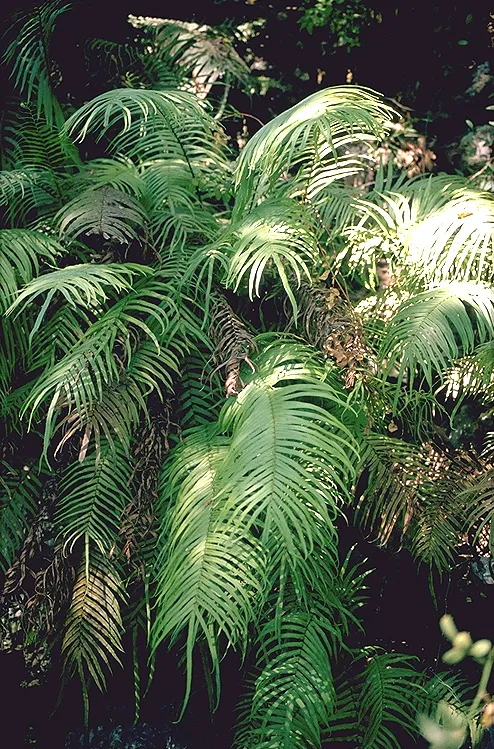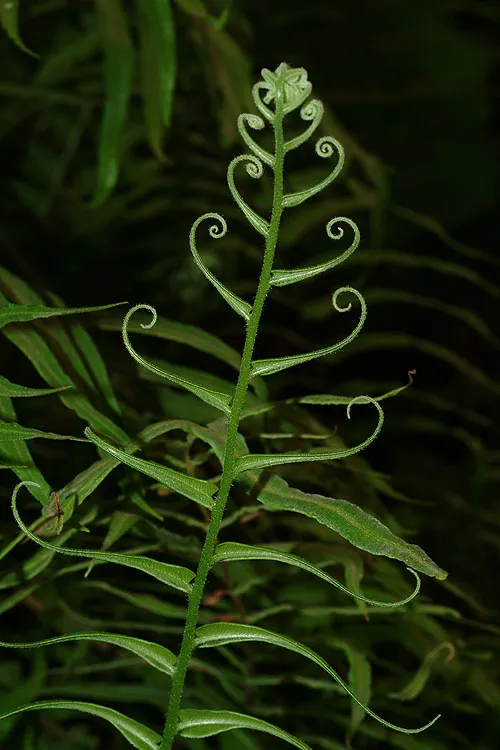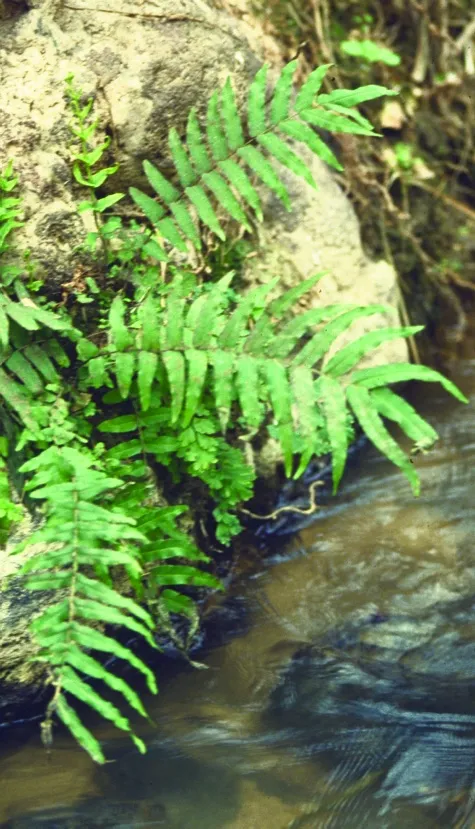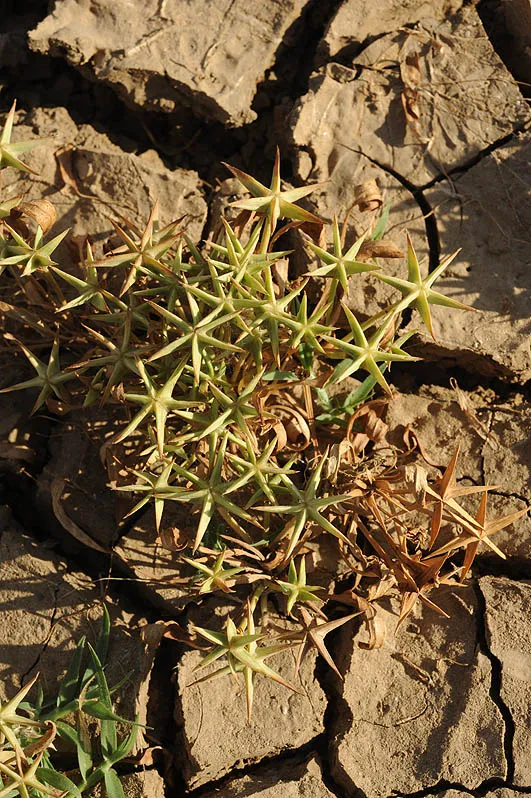Long Brake, Chinese Brake
Pteris vittata



Pteris vittata is a perennial evergreen fern. Its
rhizome is covered with scales. It has large one-pinnate fronds, up
to 1 m long, with narrow, elongated leaflets. The spores
form prominent dark strips along the leaflet margins. Spore
dispersal by wind is excellent in open areas, but not in the
shade or when the plant grows in cultivated gardens, in
shady courtyards or potted in houses. It is the source for many
dispersed spores that become established in damp pits (natural
or artificial) located in natural open areas (Atai Yoffe, personal
communication).
In the past Pteris vittata grew in the western Upper Galilee in the Kziv Stream (Hardalit Spring, last gathered in 1979) and in the Betset Stream (the Herbarium specimen is from 1939), where it grew until the 1960s. The Western Galilee populations are now extinct. Pteris vittata now grows in six locations, one of which is completely natural: the Wadi En Gev waterfall in the southern Golan. In the Hula Valley, the species is found in one of the sections of the Dan Stream near Kibbutz Dafna (it could be naturalized but is found here in natural and appropriate habitat). Pteris vittata was observed at four locations in artificial habitats, and the plants are undoubtedly from a cultivated source: on the wall of a sports field in Haifa, at Migdal Tsedek (Afek) near Rosh HaAyin, in a pit ("Bor Shuka") in Qula Forest near Shoham, and in a karstic pit near Kfar Etzion. Recently Michael Blecher reported that Pteris vittata was growing in the En Gedi Reserve in the En Gedi channel. In Flora Palestina it appears as a plant collected in the past on the Carmel, but there is no evidence in the Hebrew University Herbarium or in other literature.
Pteris vittata grows on banks of clear water rivers. In Israel, it grows near springs and flowing streams and on damp walls. The habitat of the Wadi En Gev population is a cliff with dripping water near a spring that flows within the ecotone vegetation belt, in an environment that suffers from drought stress many months a year. This is unlike extinct P. vittata habitats in the Western Galilee that are found in a humid climatic region with abundant rain (800 mm) and high humidity even in summer. It is very possible that the En Gev site is also not be a typical habitat and that the species spread there via spores from cultivated plants, a relatively common phenomenon in ferns that has been observed in Israel in a number of cases.
The genus includes 280 species of perennial ferns, many of which are cultivated as shade plants. The species in this genus have a pantropical distribution, but they spread northward to Japan and the United States, to South Africa and New -Zealand. These are sun-loving plants, but need moisture and well-drained moderately acidic soil. They are sensitive to frost.
• The main danger facing the species is habitat loss due to the general decline of aquatic and moist habitats. The number of locations where the plant grows has drastically decreased in recent decades. Surveys conducted in Western Galilee in 1986, 1990 and 1991 found no specimens of Pteris vittata.
• Populations are limited to dense patches in moist, shady habitats. The natural populations are tens of kilometers apart.
• It is neither rare nor endangered globally.
• The species has been designated a protected natural value in Israel, but is not found in any nature reserves.
• The species is being reintroduced to the Kziv Stream. The spores of an individual planted at the Ziv Spring, will hopefully disperse and establish a population.
The species should be propagated in botanical gardens and plant nurseries from spores from the En Gev or Dafna populations and re-planted in the Betset Stream and Kziv Stream reserves; the En Gev population should be nurtured and protected.
The species has a broad range that according to the Flora Palaestina and to Zohary (personal communication) includes the Mediterranean Basin and the western Euro-Siberian region, penetrating into the Irano-Turanian region in southern Russia. According to Flora Europaea, the Israeli species is common in tropical Africa and Asia and in the Mediterranean Basin.
A large pinnate fern. Formerly found on the edge of streams in the western Upper Galilee, but is now extinct there. At present, only a single natural site is known inWadi En Gev in the Golan, as well as a number of sites with populations that are probably feral. It is seriously threatened due to its rarity and the vulnerability of flowing stream habitats. The En Gev population should be monitored and reintroduced to the Kziv and Betset streams.
כהן ע. וא. שמידע, 1992 – אברה ארוכת-עלים, במדור: צמחים נדירים בישראל. "טבע וארץ", 247,34-37
נמליך, ח. ואלטיזר, י. 1985. השרכניים בשראל. הוצאת דביר, ירושלים-תל אביב.
Current Occupancy Map
| 1000 squre meter pixel | 5000 squre meter pixel | 10000 squre meter pixel | |
|---|---|---|---|
| number of observations | 0 | 0 | 0 |
| in total pixels | 0 | 0 | 0 |
| Family | Pteridaceae |
| Classification | On the endangered species list |
| Ecosystem | Mediterranean |
| Chorotype | Multi-regional, Mainly Tropical Mediterranean |
| Conservation Site | Kziv Stream and Betset Stream |
| Rarity |
1
6
6
|
|---|---|
| Vulnerability |
0
3
4
|
| Attractiveness |
0
2
4
|
| Endemism |
0
0
4
|
| Red number |
1
6.3
10
|
| Peripherality | N |
| IUCN category | DD EW EX LC CR EN VU NT |
| Threat Definition according to the red book | Critically endangered |
 Participated:
Participated:






